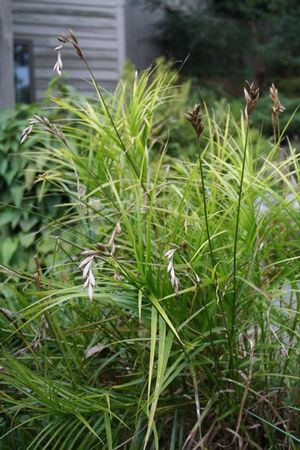New Moon Nurseries

Palm sedge forms dense clumps and is a good choice for wetland areas and stormwater management projects.
Carex muskingumensis
Palm sedge
Native to North America
FIRST IMPRESSIONS: Carex muskingumensis is a dense clump forming wetland sedge with striking texture. Leaves are attractive, bright green and reminiscent of palm fronds. In summer triangular leafy stems rise slightly above the foliage bearing narrow ellipse shaped spikelets. Carex muskingumensis prospers in shaded or partly shaded wet sites but will tolerate sun if sufficient moisture is present.
HABITAT & HARDINESS: This species is native to Ontario and the central United States from Minnesota to Ohio and south to Arkansas. The greatest distribution is in states surrounding the Great Lakes.
Carex muskingumensis is indigenous to wooded lowland and shaded wet sites like swamps, sloughs, wet woodlands, bottomland forests, river floodplains and sedge meadows.
Hardy from USDA Zones 4-7.
PLANT DESCRIPTION: Carex muskingumensis grows in handsome rounded clumps and forms colonies from short creeping rhizomes and by self-seeding. Foliage greens and initiates growth in early spring before the warm season grasses begin to grow.
In late spring multiple rigid upright culms rise above the basal foliage. The culms are leafy with numerous glossy blades that are up to 2’ long. The wide spreading leaves are densely arranged on each erect culm giving the appearance of a pinnately compound palm frond. Foliage develops a pleasing yellow fall color.
Each fertile culm is topped by a narrow inflorescence containing several 1” light green to brown spikelets. The spikelets are elongated and pointed or narrow at each end. Staminate florets are located toward the bottom of the spikelet. Pistillate florets with their long slender perigynia are located toward the top.
At maturity the lightweight perigynia are easily windblown or carried by water to efficiently distribute the achene seeds inside.
Plants are 2-3’ tall with an equal spread.
CULTURAL & MAINTENANCE NEEDS: Carex muskingumensis prospers in dappled to full shade in moist fertile soil. Plants tolerate sun if soil is consistently moist. This sedge also thrives in clay soil or shallow standing water.
Plants may flop in dense shade. In garden situations appearance is improved if plants are cut to the ground in late winter.
This sedge is pest resistant and fairly unpalatable to deer and other herbivores.
For use as a groundcover plant on 1’ centers for quick cover.
LANDSCAPE USES: Carex muskingumensis is a useful component of Wetlands and Water Gardens. The striking foliage and yellow fall color make it an ideal Accent. Plants are practical for Erosion Control and Stormwater Management and appropriate for Groundcovers, Mass Plantings, Deer Resistant Plantings, Rain Gardens, Low Maintenance Plantings, Roadsides, Restoration Projects and Wildlife Gardens.
COMPANION & UNDERSTUDY PLANTS: Try pairing plants with Anemone canadensis, Asclepias incarnata, Chelone glabra, Eupatorium purpureum, Iris versicolor or Lobelia siphilitica.
Carex grayi grows in similar cultural situations and can be substituted if needed. The species can be replaced by Carex muskingumensis ‘Oehme’ in garden situations.
TRIVIA: Caterpillars of several species of skippers and moths feed on the foliage. Many species of wetland birds feed on the seed and seek cover in the foliage.
The strange sounding specific epithet is in reference to the Muskingum River in Ohio where this sedge is found.
Several cultivated varieties of this species have been introduced in Europe and the United States.
Height:
2-3 ftSpread:
2-3 ftSpacing:
12-18 inUSDA Hardiness Zone:
4-7Bloom Color:
Green, TanCarex muskingumensis Characteristics
Attributes
- Drought Tolerant
- Naturalizing
Exposure
- Full Sun to Partial Shade
Deer Resistant
- Deer Resistant
Flowering Months
- July
Grass Season
- Cool Season Grass
Soil Moisture Preference
- Moist to Wet
Interesting Notes:
For more information on this plant, visit the USDA PLANTS Database: http://plants.usda.gov/java/profile?symbol=CAMU9